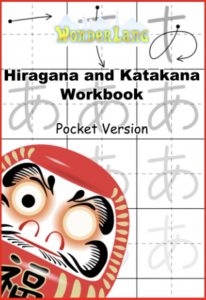Hi,
This post presents one of the most useful tool available to learn speaking Japanese: rōmaji.
| Amazon.com |  |
Amazon.ca |
As quickly explained in my post The Japanese Writing System, rōmaji is a transcription mean that was invented to standardize the way Japanese syllables should be written using the roman alphabet (a, b, c, d…). There exists many rōmaji transcription systems but the Hepburn system which I will present has become lately the most commonly used, be it in books, on road signs, on TV or over the Internet, thus making knowing what rōmaji is and how to use it key for learning Japanese.
Yet, one of the difficulties with using rōmaji is that if it provides a standard way to write Japanese with our roman alphabet, it does only give a slight idea on the way it should be pronounced. This is mainly due to the fact that the persons that invented these systems did it in regard to their home language, and as you may know the letter a is pronounced quite differently in English and in French for instance. The objective of this post is therefore to provide English speakers with some indication on how the different letters used in the Hepburn romaji alphabet shall be pronounced.
First thing, the whole Japanese syllables are build around 5 vowels, with either the vowel alone or the use of some consonants as a prefix. The only exception to the rule is the [n] which can be alone.
The table below presents the different sounds available in Japanese (click on the cell to listen to the pronunciation of the syllable):
a |
i |
u |
e |
o |
ka |
ki |
ku |
ke |
ko |
ga |
gi |
gu |
ge |
go |
sa |
shi |
su |
se |
so |
za |
ji |
zu |
ze |
zo |
ta |
chi |
tsu |
te |
to |
da |
ji |
zu |
de |
do |
na |
ni |
nu |
ne |
no |
ha |
hi |
fu |
he |
ho |
ba |
bi |
bu |
be |
bo |
pa |
pi |
pu |
pe |
po |
ma |
mi |
mu |
me |
mo |
ya |
yu |
yo |
||
ra |
ri |
ru |
re |
ro |
wa |
wi* | we* | wo |
|
n |
||||
kya |
kyu |
kyo |
||
gya |
gyu |
gyo |
||
sha |
shu |
sho |
||
ja |
ju |
jo |
||
cha |
chu |
cho |
||
nya |
nyu |
nyo |
||
hya |
hyu |
hyo |
||
bya |
byu |
byo |
||
pya |
pyu |
pyo |
||
mya |
myu |
myo |
||
rya |
ryu |
ryo |
(*) These syllables and the corresponding characters are no longer used in modern days but can still be found in many texts published even after WWII.
One important point regarding the use of rōmaji is the use of upper-cases and lower-cases.
When dealing with kana, lower-case characters are used to denote hiragana, and upper-cases to denote katakana. For instance hon will be used for ほん, and NŌTO (or NO-TO) for ノート.
When dealing with kanji, lower-cases are used to picture semantic reading (kun-yomi), and upper-cases for phonetic pronounciation (on-yomi). This is the example taken in the introduction article with 私 which can be pronounced watakushi, watashi or SHI.
Regarding the meaning of the color of the cells: blue cells indicate the use of diacritic signs, and red cells the use of two characters to form a new syllables. You will find more details on these points in the articles on kana: Introduction to Hiragana and Katakana.
Stéphane
 |
 |
 |
 |
 |
|||
